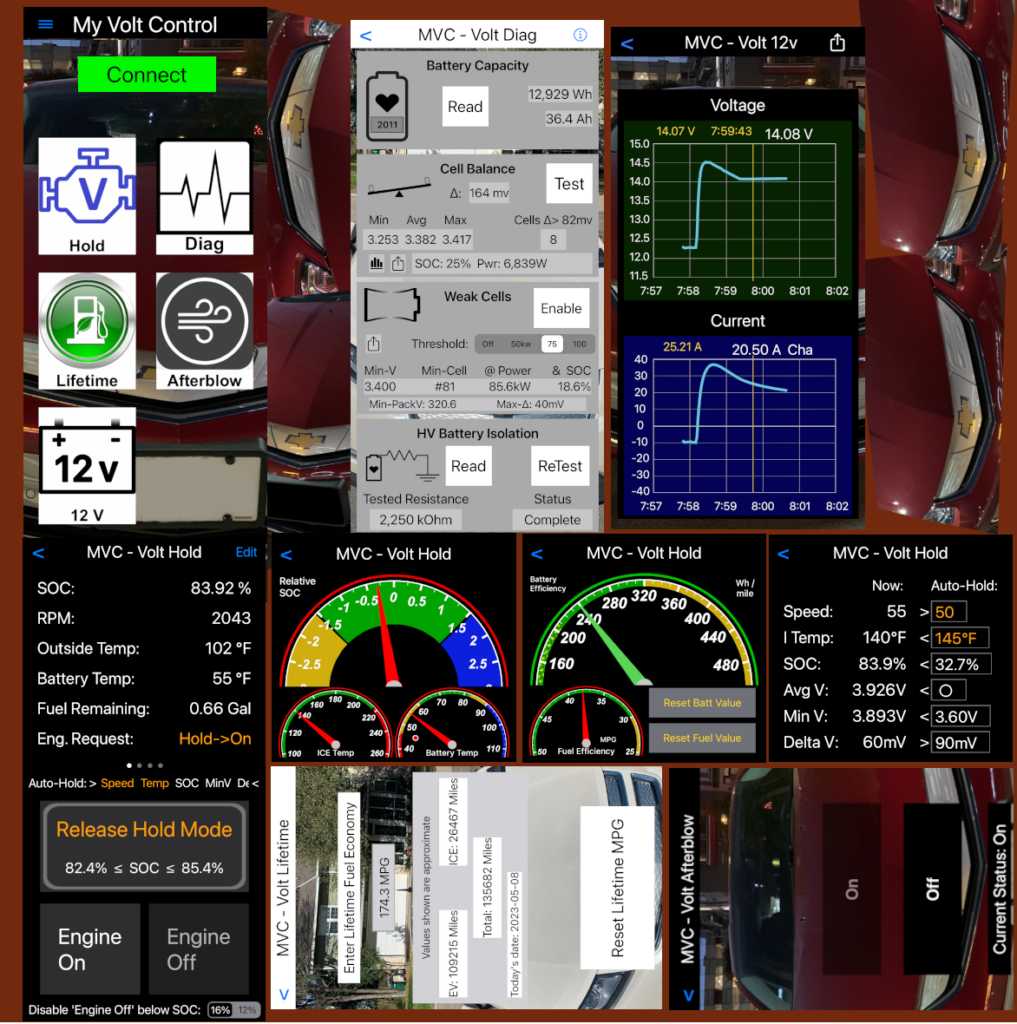MyVoltControl

MyVoltControl is designed specifically for the Chevrolet Volt and the Chevrolet Bolt (and related models). (“Related models” include the Cadillac ELR, Cadillac CT6-PHEV, Opel Ampera, Holden Volt, Opel Ampera-e.)
MyVoltControl requires the use of an OBD adapter that complies with the ELM327 specification (most do). You can use either:
- an OBDLink MX+ OBD adapter (preferred)
- an OBDLink MX-WiFi OBD adapter
- a Bluetooth 4 (aka Bluetooth Low-Energy (BLE)) OBD adapter (but most won’t work for the Volt Afterblow function).
- a generic WiFi OBD adapter will work in most cases but are not recommended.
If you need to buy an adapter, or to see a list of some that we know aren’t ELM327 compatible, refer to this informaton.
These adapters plug into the OBD-II port under the left side of your dash.
The App itself is free. Use of the functions described below requires an in-app purchase to enable each one that you want to use.
The Volt Hold Function does four things:
- First, at the top, it has several “information pages” that you can switch between to see information about your car. These are shown in the photos above. One of the information pages shows you the electric efficiency and the fuel efficiency of your car, calculated in a more useful way.
- Second, it allows you to turn on a “Hold” mode which approximates the Hold mode built into the car beginning with the 2013 model. This Hold mode turns on the internal combustion engine (ICE) as needed to try to maintain a State of Charge value that is close to the charge that was present when you turned the mode on. So why, you may ask, would I want that function on a newer car. Very simple really. Since Sport mode and Hold mode are mutually exclusive, this function allows you to use the car Mode button to engage Sport mode, while using the Hold function in this App to achieve Hold mode at the same time! There is also an “Auto-Hold” option that supports automatically engaging “Hold” mode when user-specified thresholds are crossed for several different parameters, or at vehicle speeds above a specified value.
- Next, it allows you to ask the car to run the internal combustion engine. You can use this to get heat from the engine on a cold morning, or to manually simulate your own Hold mode if you prefer.
- Finally, you can also use this function to force the ICE off, which you might want to do if the ICE is running due to low temperature (done for driver comfort).
The Volt Hold function is not available (and would serve no purpose) on the Chevrolet Bolt models.
The Volt Lifetime Function allows you to reset the lifetime fuel economy value for your car (“Lifetime MPG” or “Lifetime L/100km” depending on your car settings). You will find this useful if you’ve purchased a car which has recorded the previous owner’s Lifetime results. It will also calculate for you the distance traveled in both ICE and EV modes when you enter the Lifetime Fuel Economy value shown on your dash. The Volt Lifetime function is not available (and would serve no purpose) on the Chevrolet Bolt models.
The Volt Diag Function allows you to run some tests on your high-voltage (traction) battery.
The Volt Afterblow Function allows you to control a system that GM added to your car to dry out the A/C system. This Afterblow system is OFF by default and the Volt Afterblow function allows you to check the current status and to turn it on (or off). This app function is not available for 2013, and some late-build 2012 model year cars.
Important Note: You can use the My Volt Afterblow feature ONLY if you are using an OBD adapter which supports the SWCAN (aka GMLAN) bus. It must also support the “ST” command set (in addition to the common “AT” command set). The known-good and recommended adapters for this are the OBDLink MX+ or the OBDLink MX-Wifi adapters.
The Volt 12v function allows you to look at the voltage of, and current into, the 12 volt AGM battery in your car. Measurements are made every 2 seconds and the most recent ~5 minutes of data is presented in two graphs, with the last measured values also shown as numeric values on the screen. Dragging your finger over the graphs area will open a cursor which will allow you to see the exact values that are shown by the graphs